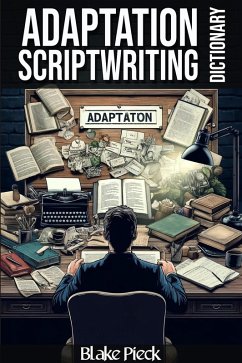
Television Scriptwriting Dictionary (Grow Your Vocabulary) (eBook, ePUB)

PAYBACK Punkte
0 °P sammeln!
This book is a comprehensive guide to the unique aspects of writing scripts for television series. From structuring individual episodes to developing overarching story arcs, this dictionary provides aspiring and experienced television writers with the tools and techniques needed to create compelling and successful television shows.Through clear and concise entries, the Dictionary provides readers with a comprehensive and accessible reference to the key concepts and techniques used in writing scripts for television series. Whether you're a novice writer looking to break into television or an ex...
This book is a comprehensive guide to the unique aspects of writing scripts for television series. From structuring individual episodes to developing overarching story arcs, this dictionary provides aspiring and experienced television writers with the tools and techniques needed to create compelling and successful television shows.
Through clear and concise entries, the Dictionary provides readers with a comprehensive and accessible reference to the key concepts and techniques used in writing scripts for television series. Whether you're a novice writer looking to break into television or an experienced professional seeking to hone your craft, this dictionary is an invaluable resource for mastering the art of television scriptwriting.
Episodic Structure: This section explores the typical structure of a television episode, including the teaser, acts, and tag. Topics include the purpose and function of each part of the episode, techniques for creating cliffhangers and keeping the audience engaged throughout the episode, and the differences between episodic and serialized storytelling.
Show Bible: Here, readers will learn about the importance of the show bible in television production. Topics include the components of a show bible, such as character descriptions, episode summaries, and series overview, as well as the role of the show bible in maintaining consistency and continuity throughout the series.
Pilot Episode: This section focuses on the pilot episode, which serves as the introduction to the series and sets the tone and style for the rest of the show. Topics include the key elements of a successful pilot episode, techniques for establishing the series premise and introducing the main characters, and the importance of a strong pilot in selling the series to networks and audiences.
Multi-Episode Story Arcs: Readers will delve into the use of multi-episode story arcs in television series, where a story or character arc unfolds over several episodes. Topics include planning and executing a multi-episode arc, creating suspense and anticipation for the resolution, and balancing the arc with standalone episodes to keep the audience engaged.
Commercial Breaks and Act Structure: This section explores the role of commercial breaks in television storytelling and the structure of acts within an episode. Topics include the use of act breaks to create tension and pacing, techniques for writing effective act endings that keep viewers tuned in, and the impact of commercial breaks on storytelling and episode structure.
Through clear and concise entries, the Dictionary provides readers with a comprehensive and accessible reference to the key concepts and techniques used in writing scripts for television series. Whether you're a novice writer looking to break into television or an experienced professional seeking to hone your craft, this dictionary is an invaluable resource for mastering the art of television scriptwriting.
Episodic Structure: This section explores the typical structure of a television episode, including the teaser, acts, and tag. Topics include the purpose and function of each part of the episode, techniques for creating cliffhangers and keeping the audience engaged throughout the episode, and the differences between episodic and serialized storytelling.
Show Bible: Here, readers will learn about the importance of the show bible in television production. Topics include the components of a show bible, such as character descriptions, episode summaries, and series overview, as well as the role of the show bible in maintaining consistency and continuity throughout the series.
Pilot Episode: This section focuses on the pilot episode, which serves as the introduction to the series and sets the tone and style for the rest of the show. Topics include the key elements of a successful pilot episode, techniques for establishing the series premise and introducing the main characters, and the importance of a strong pilot in selling the series to networks and audiences.
Multi-Episode Story Arcs: Readers will delve into the use of multi-episode story arcs in television series, where a story or character arc unfolds over several episodes. Topics include planning and executing a multi-episode arc, creating suspense and anticipation for the resolution, and balancing the arc with standalone episodes to keep the audience engaged.
Commercial Breaks and Act Structure: This section explores the role of commercial breaks in television storytelling and the structure of acts within an episode. Topics include the use of act breaks to create tension and pacing, techniques for writing effective act endings that keep viewers tuned in, and the impact of commercial breaks on storytelling and episode structure.
Dieser Download kann aus rechtlichen Gründen nur mit Rechnungsadresse in A, B, CY, CZ, D, DK, EW, E, FIN, F, GR, H, IRL, I, LT, L, LR, M, NL, PL, P, R, S, SLO, SK ausgeliefert werden.













